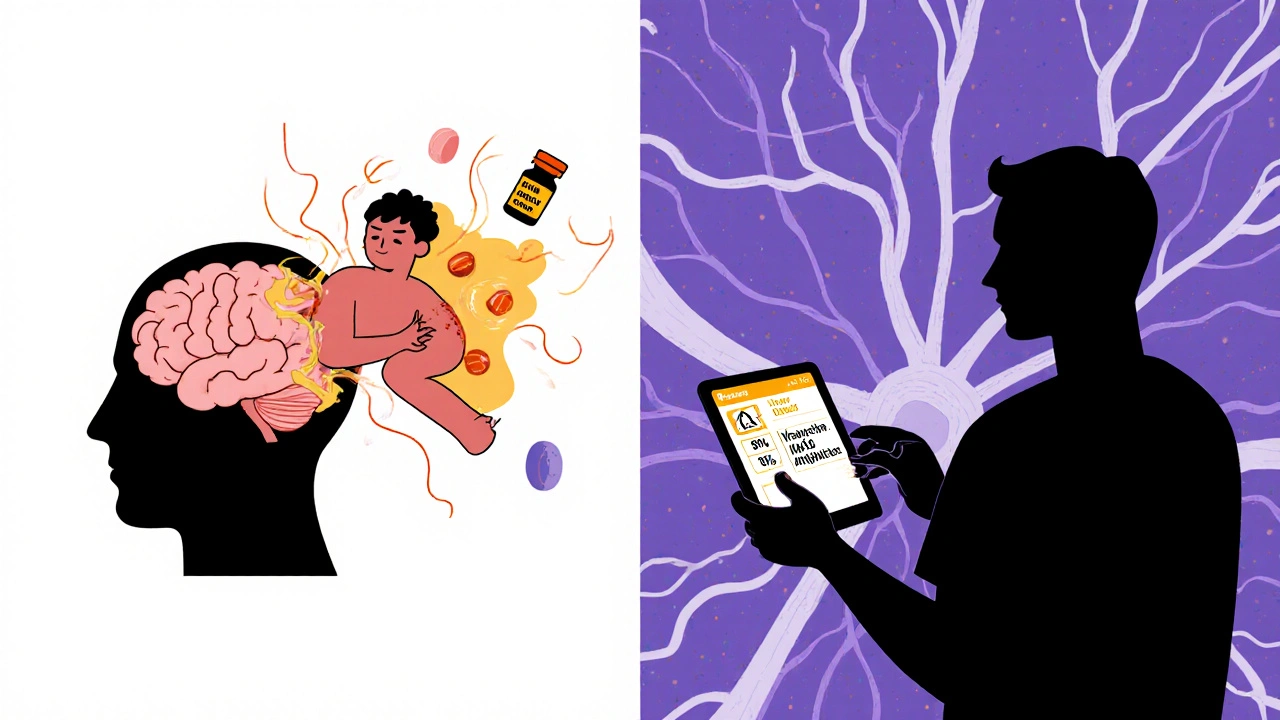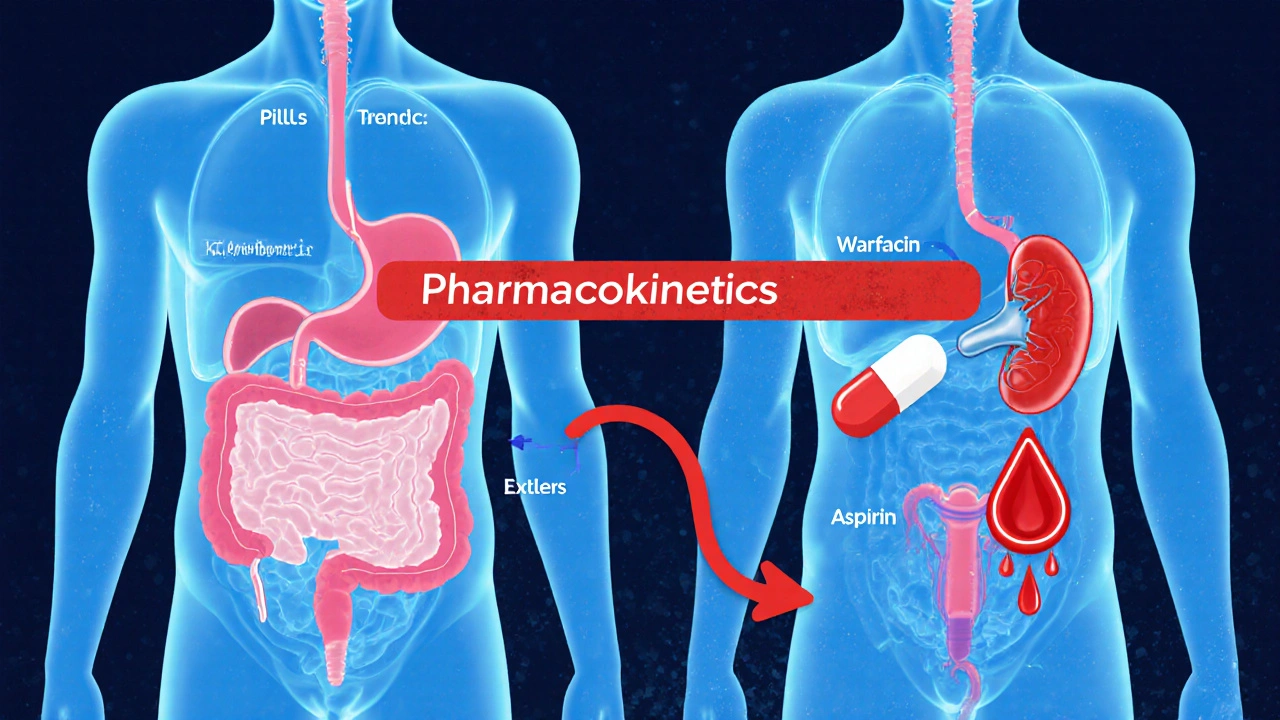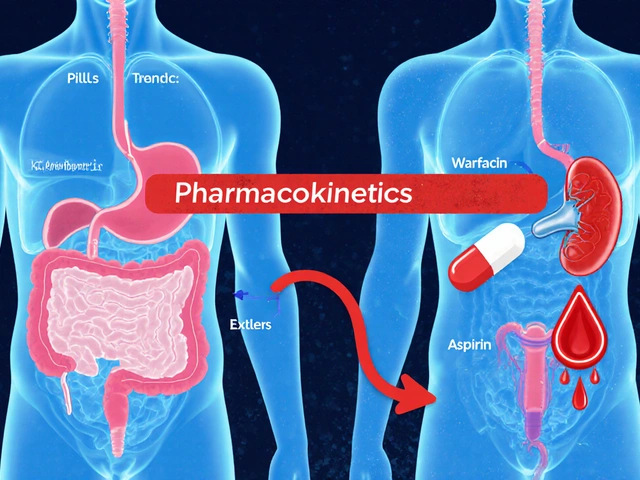PK/PD Drug Interaction Checker
Check for Drug Interactions
Enter two medications you're taking to see if they interact pharmacokinetically (affecting drug levels) or pharmacodynamically (affecting body response).
Two drugs taken together can either save your life or land you in the hospital. It’s not magic-it’s science. And at the heart of that science are two concepts that every patient on multiple medications should understand: pharmacokinetic and pharmacodynamic interactions. These aren’t just terms for pharmacologists. They’re real, life-changing forces shaping how your pills work-or don’t work-together.
What’s the difference? One changes your drug levels, the other changes how your body reacts
Think of pharmacokinetics as what your body does to the drug. It’s all about absorption, distribution, metabolism, and excretion-basically, how much of the drug actually makes it to your bloodstream and how long it sticks around. If you take an antacid with ciprofloxacin, that antacid can block up to 90% of the antibiotic from being absorbed. Your body isn’t rejecting the drug-it’s just not letting it in.
Pharmacodynamics is what the drug does to your body. This is about receptors, pathways, and effects. If you take warfarin and aspirin together, neither drug’s level changes in your blood-but together, they multiply your bleeding risk. That’s pharmacodynamics: two drugs teaming up to overdo it on the same system.
One alters concentration. The other alters response. That’s the core divide.
How pharmacokinetic interactions mess with your drug levels
Pharmacokinetic interactions happen behind the scenes in your liver, kidneys, and gut. They’re sneaky because you won’t feel them coming. Your drug levels rise or fall without you knowing-and that’s dangerous.
- Absorption: Antacids, calcium supplements, or even orange juice can bind to antibiotics like ciprofloxacin or tetracycline, stopping them from entering your system. Studies show absorption can drop by 75-90%.
- Distribution: Warfarin normally sticks to proteins in your blood. But if you add phenylbutazone, that protein gets crowded. Free warfarin spikes by 300%, turning a safe dose into a bleeding risk.
- Metabolism: This is where most serious interactions happen. Over 75% of drug interactions involve the CYP450 enzyme system, especially CYP3A4. Take clarithromycin (an antibiotic) with simvastatin (a cholesterol drug), and your simvastatin levels can jump tenfold. That’s not a typo. Ten times. That’s how you get muscle damage or even kidney failure.
- Excretion: Probenecid, used for gout, blocks the kidneys from flushing out penicillin. Result? Penicillin stays longer, boosting its effect. Useful in some cases-but risky if you’re unaware.
These aren’t rare. According to Stockley’s Drug Interactions, nearly half of all clinically significant drug interactions are pharmacokinetic. And they’re especially dangerous with drugs that have a narrow therapeutic index-like warfarin, digoxin, or phenytoin. Too little? Ineffective. Too much? Toxic.
How pharmacodynamic interactions change how you feel
Here’s where things get unpredictable. Even if drug levels stay perfect, your body can still go haywire.
There are three types:
- Synergistic: Two drugs together do more than the sum of their parts. Take sildenafil (Viagra) and a nitrate (like nitroglycerin). Both lower blood pressure. Together? They can crash it-fast. This combo is a hard contraindication for a reason.
- Additive: Their effects simply add up. Warfarin plus aspirin doesn’t change blood levels, but it doubles the chance of internal bleeding. Same with benzodiazepines and alcohol-both depress the brain. Together? Slowed breathing, coma, death.
- Antagonistic: One drug cancels out the other. Naloxone reverses opioid overdoses by kicking opioids off their receptors. Beta-blockers and beta-agonists (like albuterol) fight over the same receptors-so one can undo the other’s effect.
These interactions are especially common in the brain and heart. About 85% of CNS drug interactions-like mixing SSRIs with MAO inhibitors-are pharmacodynamic. That’s how serotonin syndrome happens: too much serotonin building up, causing fever, shaking, confusion, and sometimes death.

Why it matters: Real consequences in real lives
In the UK, 6.7% of hospital admissions are caused by adverse drug reactions. That’s tens of thousands of people every year. And about half of those are due to drug interactions.
Consider this: A 72-year-old man takes simvastatin for cholesterol. He catches a chest infection and gets prescribed clarithromycin. He doesn’t know they interact. Five days later, he’s in the ER with severe muscle pain and dark urine. His creatine kinase is through the roof. He’s had rhabdomyolysis-a condition where muscle breaks down and kills kidneys. The fix? Simple. Don’t mix those two. But without knowing the mechanism, how would he?
Or a woman on warfarin starts taking a new NSAID for arthritis. Her INR creeps up. She doesn’t feel different. No bruising, no bleeding. But her doctor doesn’t check. Two weeks later, she has a brain bleed. The drugs never changed levels-but their combined effect on clotting did.
These aren’t hypotheticals. They’re daily realities in GP clinics and hospitals across the UK.
How doctors and pharmacists manage these risks
It’s not all guesswork. There are tools, guidelines, and systems built to catch these before they hurt you.
For pharmacokinetic interactions:
- Therapeutic drug monitoring (TDM) checks blood levels of drugs like digoxin, lithium, or phenytoin. If levels spike after adding a new med, the dose gets cut.
- Dose adjustments are standard. If you need clarithromycin, your simvastatin dose drops from 40mg to 10mg-or switches to pravastatin, which doesn’t rely on CYP3A4.
- Pharmacists use tools like the Flockhart Table, which maps out which drugs inhibit or induce CYP enzymes. Epic’s EHR now flags over 1,200 high-risk pharmacokinetic interactions.
For pharmacodynamic interactions:
- It’s often about avoidance. MAO inhibitors and SSRIs? Never together. NSAIDs and ACE inhibitors? Monitor blood pressure closely-this combo can blunt the heart drug’s effect by 25-30%.
- Monitoring parameters are key. For additive CNS depressants: check breathing rate and oxygen levels. For anticoagulants: watch INR. For heart drugs: track blood pressure changes over 30 mmHg.
Pharmacists are on the front line. A 2022 study showed that when pharmacists review meds for elderly patients on five or more drugs, adverse events drop by 42%. That’s not a small win. That’s life-saving.

What’s new? AI, genetics, and bigger risks
The field is evolving fast.
The FDA now requires testing for 11 CYP enzymes and 8 transporters-up from 7 in 2017. That means new drugs are being screened more thoroughly before they hit shelves.
Pharmacogenomics is changing the game. If you’re a poor metabolizer of CYP2D6, even a normal dose of codeine won’t work. But if you’re an ultra-rapid metabolizer? You turn codeine into morphine too fast-and risk overdose. The CPIC now has 32 gene-drug pairs with clear guidelines.
And then there’s AI. A 2023 study in Nature Medicine trained an algorithm to predict pharmacodynamic interactions with 89% accuracy-beating traditional methods. It’s still in research, but it’s coming.
Novel drugs like immune checkpoint inhibitors (used in cancer) are adding new risks. Combine them with steroids or other immunosuppressants, and you can trigger severe autoimmune reactions. These interactions weren’t on anyone’s radar five years ago.
The WHO estimates better management of these interactions could prevent 1.3 million adverse events worldwide by 2030. That’s billions saved-and lives preserved.
What you can do right now
You don’t need to be a doctor to protect yourself.
- Know your meds. Keep a list-names, doses, why you take them. Bring it to every appointment.
- Ask your pharmacist. They’re trained to spot interactions. Don’t assume your doctor knows every combo.
- Don’t start new OTCs or supplements without asking. St. John’s wort? It messes with over 50 drugs. Turmeric? Can thin your blood. Garlic pills? Same.
- Watch for sudden changes. New dizziness? Unexplained bruising? Muscle pain? Fatigue? These aren’t just ‘getting older.’ They could be your drugs fighting.
- Use one pharmacy. It lets them track everything you take in one system. That’s a big safety net.
Most importantly-don’t stop or change your meds without talking to someone who knows your full picture. That’s how mistakes happen.
Can pharmacokinetic interactions be fixed with a dose change?
Yes, often. If one drug increases the level of another-like clarithromycin raising simvastatin-your doctor can lower the dose of the affected drug. For drugs with a narrow therapeutic window, like warfarin or digoxin, therapeutic drug monitoring helps fine-tune the dose. But not all PK interactions are easy to fix-some combinations are simply too risky, even with adjustments.
Are pharmacodynamic interactions harder to predict than pharmacokinetic ones?
Absolutely. Pharmacokinetic interactions follow clear biochemical rules-you can measure drug levels and model enzyme effects. Pharmacodynamic interactions involve complex biological systems: receptors, nerves, hormones, immune responses. Two drugs might affect the same pathway in unexpected ways. For example, combining an NSAID with an ACE inhibitor doesn’t change either drug’s level, but it can reduce blood pressure control by 25-30% through prostaglandin interference. That’s not in most drug labels.
Which is more common: pharmacokinetic or pharmacodynamic interactions?
Pharmacokinetic interactions are more common overall, especially in older adults on multiple meds. About 47% of significant drug interactions are PK-based. But pharmacodynamic interactions dominate in specific areas-like the central nervous system, where they make up 85% of interactions involving antidepressants, opioids, or antipsychotics. So while PK is more frequent, PD is more dangerous in key areas.
Can over-the-counter drugs cause serious interactions?
Yes-often. Many people think "OTC" means safe. But ibuprofen can increase bleeding risk with warfarin. Antihistamines like diphenhydramine can cause confusion and falls in older adults when mixed with other sedatives. Even calcium supplements can block antibiotics. Always check with your pharmacist before taking any new OTC product, herb, or supplement.
How do I know if my meds are interacting?
You might not feel anything at first. That’s the danger. But watch for new or worsening symptoms: unexplained bruising, dizziness, muscle pain, extreme fatigue, confusion, or changes in heart rate or blood pressure. If you start a new medication and something feels off within a few days, tell your doctor or pharmacist immediately. Don’t wait. Keep a symptom diary. It helps them connect the dots.
Final thought: Knowledge is your best defense
Drug interactions aren’t random accidents. They’re predictable, preventable, and often invisible. Understanding the difference between pharmacokinetic and pharmacodynamic interactions gives you power. You’re not just taking pills-you’re managing a system. And that system works better when you know how the pieces fit together.



Comments
Thank you for this incredibly thorough breakdown. As a clinical pharmacist, I see these interactions daily-especially in elderly patients on polypharmacy. The CYP3A4/simvastatin/clarithromycin example is textbook, and yet it still happens because patients don’t connect the dots between their antibiotics and their cholesterol meds. We need more public education like this.
One addition: even OTC antacids like Tums can interfere with thyroid medication absorption if taken within two hours. Small details matter.
Also, I’m glad you mentioned pharmacists. We’re not just dispensers-we’re safety netting the system. Please, if you’re on five or more meds, schedule a med review with your pharmacist. It’s often free.
Knowledge truly is power. And you’ve just handed someone a flashlight.
Of course it’s science. But why do Americans let Big Pharma push drugs without warning labels? We’re the only country that allows direct-to-consumer ads. That’s why people don’t know this stuff. Stop blaming patients. Blame the system that profits from ignorance.
Wait so you’re saying if I take my Adderall with my coffee, that’s a pharmacodynamic thing? Because both make me jittery? Or is that just me being a caffeine zombie?
I mean, I get the liver stuff. But what about weed? Does that mess with my blood pressure meds? Or is that just ‘vibes’?
This is so important 💙
I’m 68 and on 7 meds. I didn’t know St. John’s Wort could mess with my antidepressant until my pharmacist stopped me at the counter last month. I thought herbal = safe. Nope.
Thank you for writing this. I’m printing it out and bringing it to my next appointment. My doctor needs to see this too 😊
Man, I used to think ‘drug interaction’ was just some fancy term doctors used to scare people into buying more pills.
Turns out, it’s like throwing two different video game controllers into the same console-sometimes they just short-circuit the whole system.
That simvastatin and clarithromycin combo? That’s like giving your body a 10x speed boost on a rollercoaster with no brakes. No wonder people end up in the ER.
And yeah, your pharmacist? They’re the unsung heroes. I started using one pharmacy and now they catch stuff my doctor misses. Like when I was taking turmeric for ‘inflammation’ and they were like, ‘You’re on warfarin, right? Yeah… that’s a bad combo.’
Stop guessing. Ask. Write it down. Don’t be cool about it. Your life’s not a TikTok trend.
Wow. So many words for something that’s just: don’t mix pills without asking.
Why do Americans need a 2000-word essay to understand that?
This is just common sense. Why is this even a thing? People take pills like candy. I’ve seen my neighbor take her blood pressure med with grapefruit juice and then wonder why she passed out. No wonder hospitals are full.
Also why are you even talking about AI? Just tell people to stop being lazy and read the damn leaflet.
And why is everyone so surprised? This isn’t rocket science. It’s basic biology.
Also I’m pretty sure you’re just trying to sound smart. Like, you didn’t need all those bullet points. Just say: ask your pharmacist. Done.
Pharmacokinetics is a construct. A bureaucratic taxonomy. The body doesn’t care about your CYP450 enzymes. It just reacts. You’re assigning meaning to chaos.
Also, AI predicting interactions? That’s just replacing one flawed system with another. Humans are the problem. Not the science.
And yes, I take my meds with orange juice. I’m not afraid of your graphs.
They call it science. But really, it’s just another way for the medical-industrial complex to keep you dependent.
You say ‘knowledge is your best defense.’ But what if knowledge itself is the trap? What if understanding these interactions only makes you more anxious? More obedient? More likely to trust the system that created the problem in the first place?
What if the real interaction isn’t between drugs-but between you and the fear they sell you?
Maybe the answer isn’t more monitoring. Maybe it’s less medicine. Maybe it’s silence. Maybe it’s letting your body heal without interference.
Or maybe I’m just the crazy one who doesn’t take pills at all.
Either way-I’m still breathing. And I didn’t need a 12-step guide to prove it.